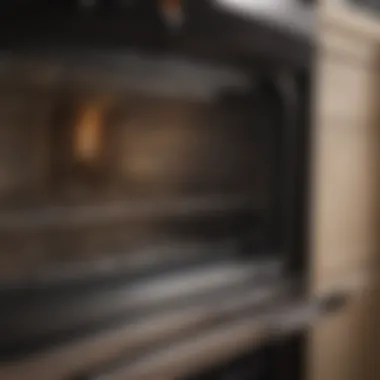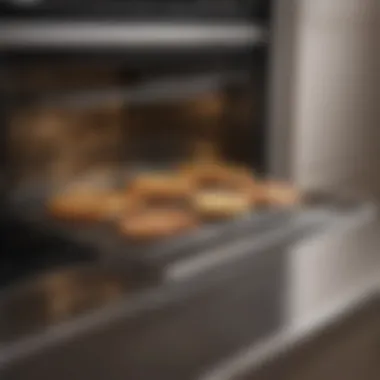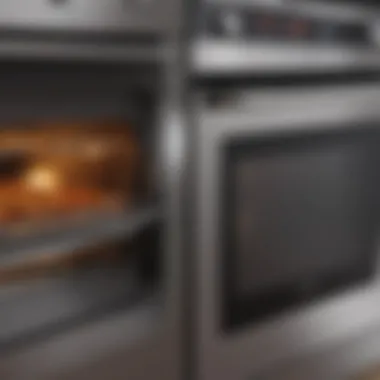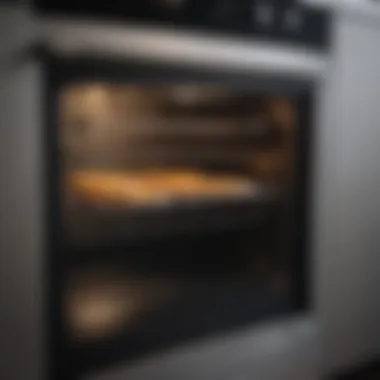Expert Tips for Cleaning the Inside of Your Oven Door


Intro
Cleaning the inside of an oven door is often overlooked, yet it is crucial for maintaining the overall hygiene and functionality of your kitchen appliances. Over time, grease and grime accumulate in these areas, contributing not only to unappealing appearances but also potentially affecting cooking performance and the flavors of the meals prepared. Many busy individuals may find it tempting to ignore this task, thinking it takes excessive time and effort. However, with the right approach and tools, keeping your oven door clean could be simpler than imagined.
In this guide, we will explore effective cleaning methods, introduce key materials, and offer practical maintenance tips. We will also discuss common challenges faced while cleaning and how you can overcome them to ensure an efficient cooking environment. The insights provided here aim to equip you with necessary knowledge for a pristine kitchen and joyful cooking experience.
Cleaning Preparation
Before delving into the cleaning process, you should gather your supplies. Essential tools include:
- Soft scrub brush or sponge
- Microfiber cloth
- Spray bottle
- Baking soda
- Vinegar
- Water
- Gloves
Ensure the oven is cold before beginning. Prepare your cleaning solution using a mixture of vinegar and water, and have materials on hand within reach. This can help save time and provide an organized workspace.
Cleaning-The-Oven-Door Tips
While preparing for this task, it’s essential to be aware of some pr as recommended actions:
- Safety First: Always wear gloves to protect your hands from cleaning agents.
- Window Pane Cleansing: If your oven door has glass panes, aim to tackle these specific areas first, as streaks are more visible here.
- Dry Thoroughly: Always ensure that surfaces are dry after cleaning to prevent moisture from effecting further dirt accumulation throughout your oven experience.
- Routine Maintenance: Establish a regular cleaning routine to strengthen your kitchen cleanliness and appliance longevity.
With these points in mind, we illustrate the steps required to efficiently clean your oven door and maintain its performance and appearance.
Understanding the Oven Door Structure
Understanding the oven door structure is crucial for effective cleaning. Knowing how it is built helps to identify the right techniques and products for cleaning without causing damage. The door comprises materials that can respond differently to various cleaning agents. Grasping these elements allows users to tailor their cleaning approaches, resulting in better outcomes while preserving the integrity of the appliance.
Components of the Oven Door
An oven door is made up of several components, each serving a specific function. The main parts include:
- Outer Frame: This is the visible exterior that provides insulation and contributes to the appliance's aesthetics.
- Glass Pane: Most oven doors have multiple layers of glass, which provide visibility into the cooking space while containing heat.
- Seal: This component ensures airtight closure to maintain cooking temperatures and prevent heat loss.
- Hinges: They allowopening and closing seamlessly, contributing to functionality.
By paying attention to these parts, one can make informed decisions about cleaning methods and avoid processes that may worsen conditions.
How Heat Affects Cleaning Requirements
Heat can make cleaning more challenging. As the oven operates, grease and food particles become baked onto surfaces. When left too long, these residues bond with the glass or metal, making them hard to remove.
- Built-Up Residue: Extended exposure to heat can cause grease to polymerize, creating a tougher surface.
- Cleaning Temperatures: Warm surfaces may make cleaning agents more effective. However, care must be taken to avoid using overly hot glass, as the shock can crack the panes.
- Products for Heat-Sensitive Areas: Choosing the right cleaning products is essential. Some cleaners may be aggressive and cause damage if they come in contact with higher temperatures.
Recognizing how heat impacts the cleaning process helps maintain a functional and attractive oven door.
Why Cleaning the Oven Door is Important
Cleaning the oven door is not merely a chore among many. For those who enjoy cooking or thrive on functioning within a hygienic kitchen setup, this task warrants considerable attention. The inside of an oven door can become a landscape for grease and splattered food debris. This accumulation can not only affect the aesthetics of the kitchen but can also influence cooking outcomes and hygiene practices. By keeping the oven door clean, you effectively enhance both cooking efficiency and overall kitchen hygiene. Maintaining clarity through cleanliness is especially crucial when it comes to tracking your meals and ensuring safe cooking practices.
Impact on Cooking Efficiency
The efficiency of your cooking significantly hinges on your oven's functionality. When an oven door is cluttered with streaks and stains, it does much more than look uninviting. Those stains obstruct visibility, making it challenging to monitor the baking or roasting progress effectively. An unclean oven can also cause uneven cooking, as impurities may interfere with the appliance’s heat distribution and prompt unnecessary energy usage.
The cleanliness of the oven door directly correlates to the quality of the dishes produced. An obstructed view means you may inadvertently alter cook times or require further energy for similar cooking results. Thus, diligently cleaning is essential to maintain optimal performance and strive for culinary excellence.


Maintaining Hygiene in the Kitchen
Promoting hygiene in any culinary space encompasses more than merely wiping down countertops and utensils. The oven's functionality and integrity play a fundamental role in fostering a healthy kitchen environment.
An oven door, harboring food residue, serves as an inviting area for bacteria and other pathogens to thrive. Regular cleaning halts the development of these potential hazards. With ovens frequently tasked for cooking various meals, cross-contamination becomes a concern. This is particularly problematic when raw foods cross paths with cooked items, increasing the risk of foodborne illnesses.
Cleaning the oven door involves selecting the right cleaning agents to ensure that sanitation is fully addressed. From natural solutions to efficient cleaning products, opting for the most effective preparation will safeguard your cooking and overall kitchen hygiene.
Regular maintenance of your oven, including the door, is vital for ensuring safety and optimal cooking standards.
By recognizing these aspects, you validate your commitment to enhancing safety and ensuring memorable cooking experiences.
Preparation for Cleaning
Preparation is a crucial aspect when it comes to cleaning the inside of an oven door. A well-prepared cleaning session not only makes the process more efficient but also ensures that optimal results are achieved. When gathering supplies and following safety precautions, one can significantly reduce the time spent and enhance the effectiveness of the cleaning process.
Gathering Necessary Supplies
Firstly, having the right supplies at hand is key to an effective cleaning task. Proper cleaning requires a few essential tools to be efficient and have good results. Here’s a list of items you will usually need:
- Gentle scrubbing pads or sponges
- Appropriate cleaning solution like white vinegar or baking soda
- A soft cloth, preferably microfiber
- Rubber gloves for protection
- A bucket for rinsing electrode sprays
- A spray bottle for easy application
By equipping yourself with these items, you train for cleaning in a nice, systematic style. The cleaning products chosen should effectively cut through grease and baked-on food stains without damaging the oven's surfaces.
Safety Precautions
Taking safety precautions is vital when preparing to clean the oven door. Ovens may retain heat longer than expected, even after being turned off. Here are some safety tips to keep in mind:
- Ensure the oven is completely cool. Allow sufficient time after usage before starting to clean.
- Use protective gear. Using rubber gloves can protect your hands from irritants and slippery cleaners.
- Ventilate the area. Open windows or turn on exhaust fans to let fresh air circulate the kitchen, especially if using strong chemical cleaners.
- Read the manufacturers cleaning guidelines. Refer to your oven’s manual as cleaning instructions can vary between different models.
Always prioritize safety. The proper preparation reduces risks associated with moisture or harsh chemicals interacting erratically with heated equipment.
By emphasizing these preparation steps, not only is the cleaning process made simpler, but possible future complications can also be avoided or prevented.
Step-by-Step Guide to Cleaning the Inside of an Oven Door
Cleaning the inside of an oven door might seem like a minor task, but it carries significant importance. An appealing oven door is not only a reflection of cleanliness but also enhances cooking efficiency and hygiene. Grease and grime that accumulate on the door can directly affect how the oven behaves while cooking. When a door is dirty, it can prevent heat from being consistently distributed, leading to uneven cooking. Furthermore, residues on the surface can lead to unpleasant odors and flavors in food. Therefore, having a clear step-by-step procedure ensures effectiveness and simplifies the cleaning task.
Powering Down the Oven
Before initiating any cleaning work, it is imperative to power down the oven. This means not only turning off the heating elements but also unplugging the appliance from the electrical outlet for safety. This step guarantees that accidental heating does not take place while you are cleaning. Double-check that the oven is completely cooled down before proceeding. Working on a hot appliance increases the risk of burns and damages.
Removing the Door (If Applicable)
In some oven models, removing the door can be the best option for cleanliness. Depending on the design of your oven, follow the manufacturer’s instructions to ensure the door is safely detached. Some models allow the door to be lifted off its hinges. If this is not possible, assess whether additional hinges or released mechanisms can assist you. Removing the door provides better access, making it simpler to clean tough stains without straining your resources.
Applying the Cleaning Solution
After the door is out or as accessible as possible, it is time to apply the cleaning solution. Common recommended cleaning solutions include specialized kitchen degreasers or a mixture of vinegar and baking soda. Make sure to apply the solution generously, focusing on heavily soiled areas. Avoiding solutions with harsh chemicals is necessary, as these can damage some finishes. Let the solution sit for the recommended amount of time per the instructions on the label or the homemade mix conditions to ensure maximum effectiveness.
Scrubbing Techniques for Optimal Results
While waiting for the cleaning solution to penetrate the grime, gather your scrubbing tools. Use a non-abrasive scrub pad or sponge to scrub the surfaces. Circular motions can be effective for adhering stains. For corners and creased areas, smaller brushes may provide much needed precision. Ensure not to apply excessive pressure to avoid scratching the glass or enamel finish, which can compromise visibility when the oven is in use afterwards.


Rinsing the Door Thoroughly
Once the scrubbing is completed, it is crucial to rinse the door well with clean water. Using a damp, clean cloth ensures all cleaning solutions are thoroughly removed. Residual chemicals left on the surface can impact future cooking and affect the flavors. Pay attention to the hinges if they have accumulated cleaning products. It's vital that no international elements hinder the door’s function post-clean-up.
Drying and Reassembling the Door
After rinsing, proceed to drying the door with a soft, lint-free cloth. This step is essential to prevent droplet stains and possible drip marks, maintaining a polished appearance. If the door was removed, gently place it back in its position once it is completely dry. Ensure it is secured properly to avoid loosening later during operation.
By following these structured steps, one can effectively clean the interior of their oven door without resulting in damage. This process overall contributes positively to the longevity and performance of the kitchen appliance.
Common Challenges in Oven Door Cleaning
Cleaning the inside of an oven door presents various challenges that, if not addressed properly, can lead to unsatisfactory results. Understanding these challenges is essential for anyone looking to maintain their kitchen effectively. This section highlights specific issues readers may encounter while cleaning oven doors. Focusing on these elements not only improves cleaning efficiency but also enhances the overall experience in the kitchen.
Dealing with Stubborn Stains
Stubborn stains can create significant hurdles when maintaining oven doors. These stains may vary from grease splatters to burnt food residue, and they often require more effort to remove. Ignoring these stains or using inappropriate cleaning methods could lead to a buildup that not only detracts from your oven's appearance but can also affect its performance.
Cleaning stubborn stains involves first assessing the stain type and texture. In many cases, a regular cleaning solution may not suffice. Instead, homeowners are encouraged to consider the following tips:
- Choose Appropriate Cleaners: Potent commercial cleaners, especially those labeled for tough stains, work effectively.
- Use a Scraper: A plastic scraper can help lift off baked-on food without damaging the glass surface.
- Soak the Area: Applying the cleaner and letting it soak for some minutes can significantly ease the scrubbing process.
With the right approach, it's possible to tackle these blemishes effectively, restoring the clarity and cleanliness of the oven glass.
Managing Scratches and Damage
While cleaning techniques play a crucial role in maintaining the appearance of oven doors, mitigating damage such as scratches is equally vital. Scratches can stem from improper cleaning tools or lack of awareness regarding the visibility impact on glass surfaces.
The consequences of scratches extend beyond aesthetic concerns, as they can accumulate grime over time, making future cleaning more complicated. Moreover, some scratches may compromise the structure of the glass. To prevent this:
- Avoid Abrasive Materials: Steel wool or harsh sponges will worsen scuffs and scratches. Use microfiber cloths instead.
- Gentle Circular Motions: If mechanical agitation is required, use gentle circular motions while cleaning. This reduces the likelihood of adding new scratches.
- Professional Repairs: For severe scratches or damage, professional repair may be advisable.
Alternative Cleaning Methods
When it comes to cleaning the inside of an oven door, exploring alternative methods can enhance the cleaning process. For individuals who are either sensitive to strong chemicals or prefer using more eco-friendly solutions, understanding these alternatives is crucial. Each option presents its own set of advantages and caveats. In this section, we will delve into two distinct cleaning strategies: using commercial cleaners and opting for natural cleaning solutions.
Using Commercial Cleaners
Commercial oven cleaners are specifically formulated to tackle tough grime and grease. These products often contain powerful chemicals that can break down stubborn stains effectively. However, there are essential factors to consider.
Key Points to Note:
- Effectiveness: Commercial cleaners are potent and often provide quicker results compared to other methods. This is beneficial for busy individuals who value efficiency.
- Ease of Application: They are ready to use. Many come in spray bottles, allowing for straightforward application on soiled surfaces.
- Safety Concerns: Always follow the instructions provided by the manufacturer carefully. Ensure the cleaning area is well-ventilated and keep such products out of reach of children.
- Surface Compatibility: Before applying a commercial cleaner, confirm it is suitable for the specific materials used in your oven door. Use on glass doors with caution, as not all products are safe.
For a precise cleaning experience, it is crucial to look for a product that aligns with your cleaning goals and safety requirements. The strong odor associated with many commercial cleaners can also be a deterrent. Hence, using it sparingly is advised during deep cleaning sessions.
Natural Cleaning Solutions
Natural cleaning solutions have become increasingly popular. Many homeowners prefer these options due to their eco-friendliness and the avoidance of chemical residues. This is particularly attractive for families concerned about toxic exposure.
Advantages of Natural Cleaning Methods:
- Safety: Ingredients such as vinegar, baking soda, and lemon are non-toxic and safe to use around food. This reassurance can add value to your overall kitchen hygiene.
- Cost-Effective: Often, these ingredients are found in the household pantry. Thus, creating natural cleansers can be gentler on your wallet.
- Surface Protection: Natural cleaners tend to be less abrasive. They won't contribute to scratching or damaging the interior glass over time.


Basic Recipe for an Effective Natural Cleaner:
- Mix equal parts of water and white vinegar in a spray bottle.
- Add a spoonful of baking soda if extra scrubbing power is needed.
- Shake gently to combine without creating too many bubbles.
When utilizing natural cleaning solutions, remember that results may take longer to achieve than with commercial cleaners. Patience is necessary. The warming of the oven slightly can yield easier cleaning with homemade solutions. In essence, natural methods promote a gentler approach to tackling the inevitable build-up without introducing harsh chemicals.
Consider your personal preferences and needs when choosing to use either option. Understanding your materials and maintaining your oven will encourage a more effective routine.
Regular Maintenance Tips
Maintaining the cleanliness of the inside of your oven door is essential for both practical and hygienic reasons. Regular maintenance not only keeps the oven looking good but also prevents the build-up of grime that can affect cooking efficiency. Mother Nature is tough on appliances, and without proper care, persistent residues and accumulations can lead to costly repairs.
The concept of regular maintenance involves a series of activities designed to uphold the functionality of the oven and enhance your cooking experience. Camps of unseen grease or burnt food waste may not seem like a big deal, but they could become a health hazard over time and even impact safety when cooking. Therefore, adopting a proactive cleaning regimen is crucial.
Establishing a Cleaning Schedule
One effective step toward maintaining the condition of your oven door is to set a dedicated cleaning schedule. This could be part of a broader kitchen cleaning strategy. Making it a habit reduces the workload associated with neglected tasks.
To consider as part of your schedule:
- Frequency: Depending on usage, establishing a routine cleaning cycle every couple of weeks may be ideal. Major cooking events or messy recipes can warrant additional attention. Be realistic.
- Combined Tasks: You may want to align oven door cleaning with other household chores, such as wiping countertops or cleaning appliances. This saves time and utilizes cleaning solutions efficiently.
- Tracking Usage: Keeping a record of your oven’s use can help manage what's necessary. An active tracking system will lead to informed decisions about cleaning intervals.
Preventive Measures to Avoid Build-Up
In addition to a simple schedule, integrating some preventive measures can significantly decrease the frequency of problems. When it comes to traditional ovens, knowledge is power. Protecting the interior from becoming overly dirty requires conscious actions.
Consider the following practices:
- Cover Dishes: Whenever possible, use oven-safe covers on dishes. This keeps vapor and food particles contained and reduces splatter.
- Regular Inspection: Check the door and surrounding areas after use. If you notice spotty grease or food residue, tackle it immediately. This stops bigger messes before they happen.
- Spill Services: Immediately addressing spillages inside the oven can save considerably. If liquid or bits of food escape during cooking, let them cool and wipe off promptly.
- Use of Appropriate Cookware: Adopting quality kitchen tools designed for your oven type often leads to cleaner cooking. For an electric oven, using heatsafe glass or ceramic is usually more effective than metal pans that could stain the surface.
Implementing these measures not only maintains clean surfaces effectively but can also enhance the lifespan of your oven. Taking small proactive steps reaps substantial long-term benefits aligned with healthy cooking practices.
Routine cleaning and preventative care can save homeowners significant amounts in repair bills.
Epilogue
Maintaining a clean oven door is crucial for kitchen hygiene and cooking efficiency. An unclean oven door can trap odours, grease, and residues that may spoil the cooking process. Regular maintenance of the oven door contributes to a healthier cooking environment, ensuring that your meals are prepared in a clean area. This article has discussed numerous aspects of cleaning the inside of an oven door, emphasizing methods, concerns, and various solutions that satisfy the need for cleanliness.
Summarizing Key Points
In this article, we've explored a comprehensive approach to cleaning your oven door, highlighting key elements:
- Understanding the Structure: Recognizing the materials and components leads to effective cleaning solutions.
- Impact of Stains: Addressing how heat exposure creates challenges in cleaning the glass and other surfaces.
- Preparation for Cleaning: Gathering right supplies ensures an efficient and safe cleaning process.
- Step-by-Step Guide: Detailed methods allow for meticulous cleaning that improves hygiene.
- Common Challenges: Recognizing difficulties like stubborn stains and the proper care to avoid scratches while cleaning.
- Alternative Cleaning Methods: Providing options between commercial cleaners and natural solutions gives flexibility based on user preference.
- Regular Maintenance: Suggesting cleaning schedules and preventive measures minimizes build-up, thus prolonging the time between thorough cleanings.
Integrating these practices will not only enhance the appearance of your oven door but also foster a more hygienic cooking space.
Encouraging Consistency in Cleaning
Cleanliness should become a habitual task in any well-functioning kitchen. Regular cleaning of the oven door can feel like a small task, yet it plays a major role in the overall health and effectiveness of your kitchen. Setting a consistent schedule for cleaning encourages accountability and ensures that resources do not accumulate over time.
Some suggestions for establishing consistency include:
- Setting a Schedule: Choose a day each month to clean your oven door completely.
- Daily Wipe Downs: After using the oven, consider a quick wipe down to prevent build-up.
- Involving Others: If you share kitchen spaces, involving housemates can spread the responsibility.
Consistency in cleaning not only keeps your oven looking great but creates a space conducive to gastronomy. When a clean appliance is part of your cooking rituals, meal preparation becomes much more enjoyable.
“A clean kitchen reflects a clear mind; it supports creativity.”
By embracing a cleaning culture, you will enjoy a significant uptick in both functionality and pleasure when cooking.







